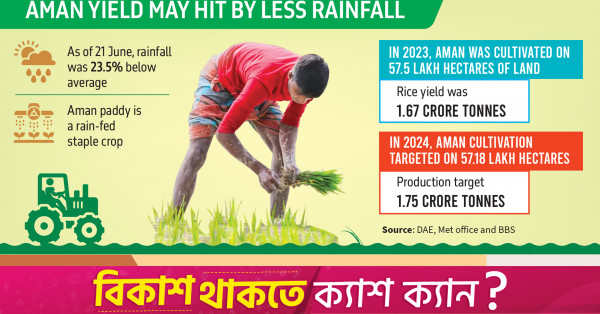Concerns over Aman yield amid quite low rainfall


Infographics: TBS
“>
Infographics: TBS
Less rainfall during the monsoon may affect the cultivation of Aman paddy, a rain-fed staple crop, this year, agriculturists fear.
Most areas in the country except Sylhet, Rangpur and Mymensingh are experiencing less rainfall. The country’s rainfall as of 21 June was 23.5% below average, according to the Bangladesh Meteorological Department.
Although clouds have been gathering in the sky across the country for about two weeks, it has not been raining that much. In some places where it has rained, the amount has been less than usual.
Yet, the planting of Aman paddy, which relies on rainfall and is the second-largest rice yield season, is in its final stages. Farmers have begun preparations for transplanting Aman paddy. In this situation, if the trend of reduced rainfall continues, there are concerns that it may adversely affect Aman rice yield, the agriculturists say.
“To effectively combat the impacts of climate change, extensive research is crucial to understand what specific actions can be taken during these times,” Agricultural economist Jahangir Alam Khan told TBS.
“Planning ahead is essential for the government to determine what supportive measures it can provide. Failing to do so could jeopardise the continuous and sustainable production of rice,” he said.
Aman season relies heavily on rainfall, and insufficient rain adversely affects cultivation, the country’s rice yield.
Badal Chandra Biswas, director general of DAE
According to the Department of Agricultural Extension (DAE), Aman paddy is cultivated on much more land compared to Boro. Last season, Boro paddy was cultivated on 50.58 lakh hectares, whereas Aman covered more than 57 lakh hectares.
On average over 1.5 crore tonnes of rice are produced during the Aman season. Bangladesh Bureau of Statistics data shows Aman paddy was cultivated on 57.5 lakh hectares of land last season, resulting in rice yield of 1.67 crore tonnes, which is 7.97% higher than the previous year.
DAE sets increased target for Aman yield
This year, the target has been set to plant Aman on 57.18 lakh hectares with an increased production target of 1.75 crore tonnes. However, without sufficient rainfall, achieving the target for Aman planting may not be possible, the agriculturists say.
Farmers had to struggle during the last two Aman seasons. Due to insufficient rainfall, many areas had to use irrigation pumps to plant paddy. Last year, over 4 lakh irrigation pumps were installed, and the year before, more than 6 lakh pumps were needed. The installation of irrigation pumps increases the cost of production and also impacts the overall yield.
DAE officials said Aman cultivation occurs in two phases. In the first phase, the early Aman is planted. In the second phase, seedlings are prepared for transplanted Aman – also known as T-Aman. This year’s target for planting early Aman in the first phase is 248,700 hectares, with approximately 70% of the area already planted.
Across the country, preparations for seedbeds for transplanted Aman are underway. These will be planted starting in about a month, provided there is sufficient rainfall. However, if normal rainfall does not occur, the seedbeds themselves may be damaged, potentially reducing production, say the agriculturists.
DAE Director General Badal Chandra Biswas told TBS, “The Aman season relies heavily on rainfall, and insufficient rain adversely affects cultivation, impacting the country’s rice yield. Last year, many areas had to use irrigation pumps to plant paddy during the Aman season due to inadequate rainfall.”
Met office forecasts increased rainfall in July
However, there is some hope amidst the situation, according to the Met office. It says while rainfall has been below normal so far this month, there is a forecast for increased rainfall next month.
Md Bazlur Rashid, meteorologist of the Met office, told TBS, “During the monsoon season, the country receives 71% of its annual rainfall. Most of this rainfall occurs in July. This year, there is a likelihood of more rainfall compared to last year. Although there has been less rainfall in the southern regions in June, the northern regions, including Sylhet, have experienced more rainfall than usual.”
He added, “During the monsoon season, even though the sky appears cloudy, most clouds do not produce rain everywhere. Thus, over the past few days, despite most of the day being cloudy in Dhaka and the southern regions, these clouds have not brought much rain to these areas. This is characteristic of the monsoon season.”
Currently, the monsoon axis extends across parts of eastern to western India, including Assam, Meghalaya, Nepal, and some areas of Sylhet in Bangladesh, he said.
“As a result, there is reduced rainfall in the southern regions, including central areas of Bangladesh. It is anticipated that this monsoon axis will continue to influence Bangladesh in July, bringing widespread rainfall, according to the latest forecasts.”
In June, the country received 18,980 millimetres of rainfall, which is less than normal. Rainfall, however, in Sylhet has been 177% higher while in Rangpur it has been 120% higher, and in Mymensingh, it has been 60% higher than average. But it is below average in the other areas.
This decrease in rainfall during June has been observed for the past two years as well.
Met office data shows in 2023, there was approximately a 14% decrease in rainfall compared to normal during the month of June. In contrast, 2022 experienced a 3.6% decrease in rainfall compared to normal, while in 2021, there was nearly an 18% deficit compared to normal. However, in 2020, there was approximately a 2% surplus of rainfall compared to normal.
Climate specialist and meteorologist Muhammad Abul Kalam Mallik told TBS, “During the monsoon season, we typically see more clouds in the sky; this is normal. However, this time, although there are plenty of clouds, they do not produce much rain because these clouds are so tiny that they precipitate as drizzle before reaching the ground due to evaporation caused by the temperature. These are referred to as ‘fair clouds’.”




